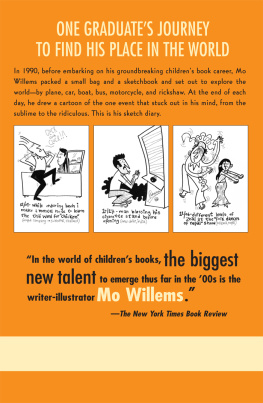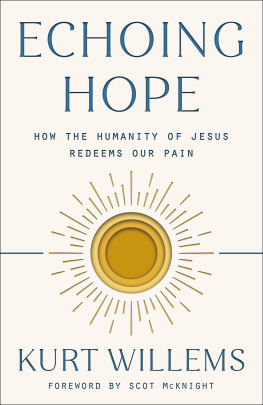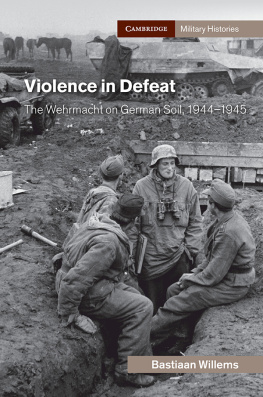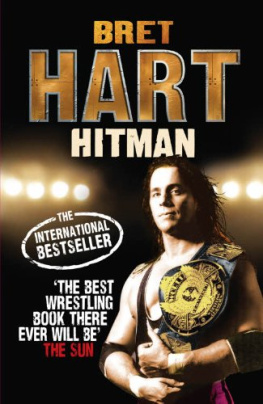

ON JUNE 1, 1990 , less than a week after graduating from college, future best-selling childrens book author Mo Willems embarked on a yearlong trip around the world. Traveling with only a notebook, pen and ink, and one change of clothes, he spent the next twelve months backpacking across more than thirty countries. Each evening, he would sit and draw a funny or touching event that had struck him that day. The cartoons feature everything from the debauchery of the running of the bulls in Spain to the Malaysian custom of burning cardboard appliances for your loved ones afterlifeall priceless details that would never be found in an ordinary travel guide.
Recently annotated by the illustrator and featuring a foreword from best-selling humor writer Dave Barry, You Can Never Find a Rickshaw When It Monsoons is a unique snapshot of an artists coming-of-age as he tries to understand the world around him.

My thanks to the world, including my parents
(to whom this book is dedicated) for giving me
both this trip and the travel bug that allowed
me to enjoy it
Text and illustrations copyright 2006 by Mo Willems
Foreword copyright 2006 by Dave Barry
All rights reserved. No part of this book may be reproduced or transmitted in any form or by any means, electronic or mechanical, including photocopying, recording, or by any information storage and retrieval system, without written permission from the publisher.
For information address Hyperion Books for Children,
114 Fifth Avenue, New York, New York 10011-5690.
First Edition
1 3 5 7 9 10 8 6 4 2
Library of Congress Cataloging-in-Publication Data
Willems, Mo.
You can never find a rickshaw when it monsoons: The world on one cartoon a day/by Mo Willems.
1st pbk. ed. p. cm.
ISBN 0-7868-3747-0 (alk. paper)
1. Willems, MoTravelJuvenile literature. 2. Willems, MoDiariesJuvenile literature. 3. Authors, American21st centuryDiariesJuvenile literature. 4. AmericansForeign countriesJuvenile literature. 5. Voyages and travelsJuvenile literature. I. Title.
PS3623.I555ZA772006
818'.603dc22
2005052722
Visit www.hyperionteens.com
CONTENTS
The first time I went abroad was in the mid-1970s, on a package tour run by TWA. There were about three dozen of us on the tour, and we all had bought new sneakers. To make absolutely sure that there was no possible way that we could be mistaken for anything other than American tourists, we also were issued plastic shoulder bags the color of stop signs, with TWA on the sides.
The tour took us to four cities: London, France, Rome, and Vienna. In each city, a uniformed TWA guide met us at the airport and put us on a bus, which took us to the official TWA-tour-affiliated hotel. Then we toured the city by bus, stopping at famous sights such as Big Ben and the Eiffel Tower, where we were allowed to briefly get off the bus so we could take photographs of ourselves standing in front of these sights, thereby documenting that we had seen them.
We also toured the countryside and stopped atthis is a very conservative estimateevery cathedral on the planet Earth. At each cathedral, the guide would point out interesting elements of the architecture, especially flying buttresses. My personal fascination with flying buttresses waned pretty quickly, but the tour guides found all of them to be absolutely riveting, and would not allow a single buttress to go unremarked.
The bus also took us to official TWA-tour-affiliated souvenir stores, where we could buy authentic tchotchkes, and at night we went to official TWA-tour-affiliated restaurants, where we could choose from two, or sometimes even one, authentic entrees.
By the end of our two-week trip to four of the great cities of Europe, every person on the tour had a deeper understanding of, and appreciation
So what are my strongest and fondest memories of this, my first trip abroad? Not the buttresses, thats for sure. No, the moments that remain most vividly lodged in brain lobes of my mind are the experiences I had on those too-rare and too-brief occasions when we were off the bus and on our own, and found ourselves face-to-face with the true essence of European culture, by which I mean: toilets.
Back in the 1970s, Europe was still using the plumbing system originally installed by ancient Romans, and I vividly recall, more than once, descending into some dank, dark restroom, where it was not easy to tell how to use the toilet, or for that matter where the actual toilet was. There was a very real danger that you would mess up and pee on a buttress. And to make the experience more unnerving, the mens toilets were often haunted, Gollum-style, by women attendants of the female gender, whose sole function, apparently, was to collect tips, a job that left them with no time for cleaning the toilets, as evidenced by the presence of carnivorous bacteria the size of Doberman pinschers.
I also vividly remember my attempts to use the municipal bus system in Rome, where I got onto a bus that I believedbecause the route map said sowas going to take me to Point A, but which in fact went to a completely different placePoint R, maybe, or even Point Zbecause (as was explained to me by a friendly Italian person who spoke some English) the bus driver, for personal reasons, preferred to go to a different destination, and was not going to be confined by some rigid route map.
so it was physically impossible to pay to ride the bus, which seemed to be fine with everybody.
So I wound up getting thoroughly lost in Rome, miles from my destination. But the price was right, and I remember that trip better than any I took on the official TWA-tour bus.
Ive done a lot more traveling since that trip, and Ive learned that this is generally true: you of course want to see the famous sights, but in the end what you remember best about traveling to a new place is what you did not already know you would find there: the quirky, the unexpected, the weird, the scary. Thats what sticks with you.
Which brings me (finally) to Mo Willemss wonderful book. In 1990, Mo traveled around the world, but he was definitely not on an official guided tour. His tour was as unofficial and unguided and random as humanly possible, and thus it was jam-packed with what I will calland I mean this in a good waytoilet moments. Fortunately for us, Mo is ideally suited to capture those moments. Hes a perceptive artist with a keen eye for the bizarre scene, the poignant detail, the amusing moment; hes also a very shrewd and very funny writer. (I love dogs, he notes, but not because theyre smart.)
So what you have in your hands is a series of memorable moments, woven together into a fascinating, unpredictable voyage around the world, led by a highly entertaining guide. Enjoy the trip: you will not encounter a single buttress.
Dave Barry
Miami, Florida
For you younger readers: TWA is a now-defunct airline that was started by Leonardo DiCaprio.
We always sat in the same seats. One time, one couple got crazy and sat in the seats that had been previously claimed by another couple, and there was nearly a fistfight.
Yiddish for crap.
If you are ever forced to choose between undergoing brain surgery with a blunt hoe or touring the World-Famous Blue Grotto, choose the surgery. I am serious.
This pretty much describes all Italians.
Next page









